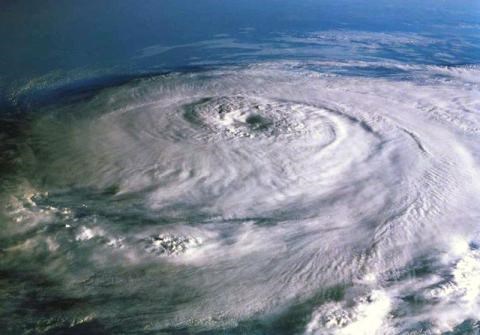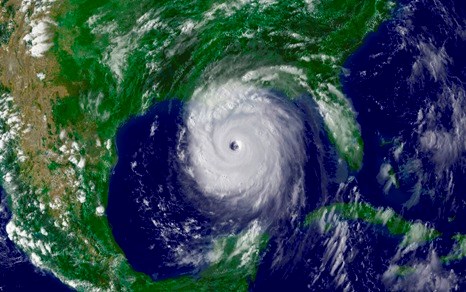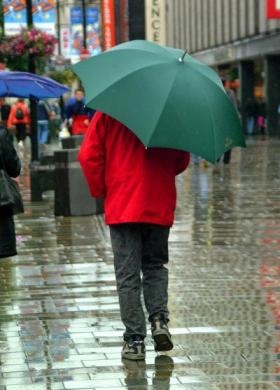 |
In some areas, these monster storm ingredients intermingle on a relatively regular basis – in others, they mix and strike entirely unexpectedly. Some of these storms, like hurricanes, for example, brew in the ocean and given modern meteorological advancements, allow time for warnings to go out publically so that residents may evacuate or take shelter. Others, like tornados, strike with little to no warning and during certain seasons, strike repeatedly, often in the same general regions.
So what exactly are some of these ‘monster storms’?
 |
| NOAA satellite image of Hurricane Katrina |
Hurricanes are considered tropical cyclones -- a low pressure system typically forming in the tropics. These tropical cyclones are joined by thunderstorms and spin in a counterclockwise fashion in the northern hemisphere, and vice-versa in the southern hemisphere, if and when they form there. The spinning winds stay near the earth’s surface.
Coastal areas are most subject to the wrath of these powerful weather systems. In fact, on average, every year 11 tropical storms are formed in the Caribbean, 6 of which turn into hurricanes. In fact, hurricanes strike some areas so often that every autumn area residents, such as those in the state of Florida, refer to the conditions as ‘peak season’ – namely August through October.
Energized by the heat of condensation created over tropical ocean waters, hurricanes often attack coastlines in a fast a furious fashion -- at times exceeding speeds of 150 mph -- yet weaken significantly over land. Oftentimes, though, the initial brunt force is enough to incur serious irreversible damage to exposed coastlines, and property and peoples nearby.
Hurricanes are classified into 5 different categories, according to the storm’s wind speed, central pressure, and the potential for damage upon landfall that it may have. Categories 1 and 2 are dangerous and require safety precautions, of course, but categories 3 and over are considered 'major' hurricanes, and typically create vast destruction upon landfall.
The most talked about hurricane in recent history is Hurricane Katrina, a category 5 storm. Violently attacking the city of New Orleans, Louisiana, and several surrounding areas throughout Louisiana and Mississippi, it left a heavy imprint upon the homes of thousands, and the hearts of millions. Taking scores of lives and devastating the local economy, Katrina’s wrath is still felt years later in an area feverishly working to rebuild itself from a true ‘monster storm.’
 |
Though every state is susceptible to these whirling wonders, “Tornado Alley,” an area in the middle of the U.S. referred to as the Central Plains, just east of the Rocky Mountains, is where tornadoes are likeliest to occur, particularly from March until August. Scientists don’t entirely know how tornadoes form, but they do know that the typically happen when dry, cool air from the north mixes with moist warm air from the south. They begin with a powerful, severe thunderstorm, then once created, look like a funnel shaped cloud, rotating in an incredibly fast and violent column of air traveling at speeds of up to 300 miles per hour! Initially, tornadoes sometimes appear nearly transparent, until they start picking up dirt and debris in their path.
Tornadoes occasionally travel in pairs, with more than one striking the same area at the same time. Sometimes tornadoes also accompany tropical storms and hurricanes that have made landfall, making conditions doubly dangerous for areas already affected by the other ‘monster storms.’
Tornadoes are actually considered nature’s most violent storms, because they come on so fast and furiously, and typically, very unexpectedly.
They are also quite large, and can damage, and in some cases, level, areas a mile wide and 50 miles long. They have been known to demolish entire neighborhoods, and oftentimes the property and debris they pick up are carried for miles.
Unfortunately, because they form so quickly and fiercely, scientists are very limited in their ability to predict tornadoes and communities are often struck with little or no warning. Meteorologists typically put out a ‘tornado watch’ to let citizens know that tornadoes are possible given the presence of tornado ‘ingredients,’ but an official tornado warning is not given until a tornado has actually been sighted. At winds speeds of up to 300 mph, though, that could mean very little time to seek shelter.
Another type of tornado is called a ‘waterspout.’ Far less dangerous than it’s land-faring counterpart, these weak tornadoes form over warm water, typically in the Gulf of Mexico. Waterspouts typically occur outside of what is generally considered tornado season, developing out of cold late fall or winter storms. It is only when these waterspouts move inland and become tornadoes, though, that they become a real threat to humans, animals, and property.
Tornadoes make up a part of weather systems that are considered ‘monster storms,’ attacking randomly and violently and destroying the lives and livelihood of many. Though scientists are working feverishly to better develop warning systems for these unpredictable funnel cloud formations, as of yet, these monster storms remain difficult to fully understand and likewise, difficult to predict.
 |
| Image from FreeFoto |
Yet for those living in areas particularly prone to these monster storms, it is important to take heed to the warnings of meteorologists and to proceed with caution when a storm is impending.
Whether the storm is a hurricane which has been brewing for some time and is churning its way towards a populated region, or a tornado which formed seemingly instantaneously -- precautions need to be taken. This begins with a preparedness plan of action for if and when these monster storms do occur, and whenever possible, a storage of available supplies with which to survive until the region is able to repair its infrastructure -- namely its electrical circuitry, plumbing, and the like. Although particularly pertinent to people living in areas most typically affected by these weather systems, monster storms can strike anywhere, given the right ingredients, and likewise, it is important for everyone, everywhere, to understand the nature of these storms, and how to best stay safe in the event of their occurrence.
Page created on 2/20/2008 10:41:55 AM
Last edited 2/20/2008 10:41:55 AM
